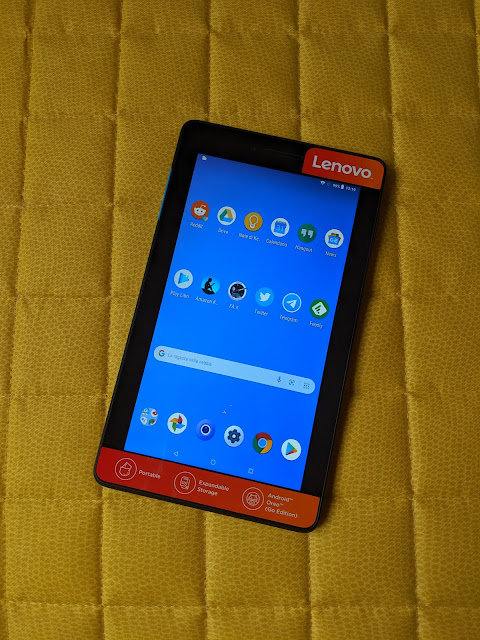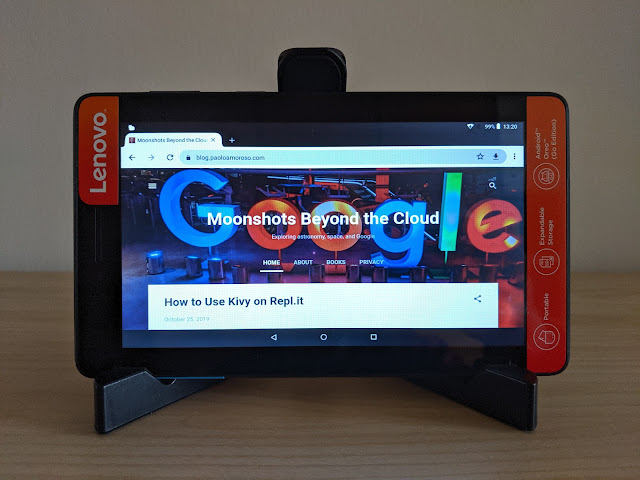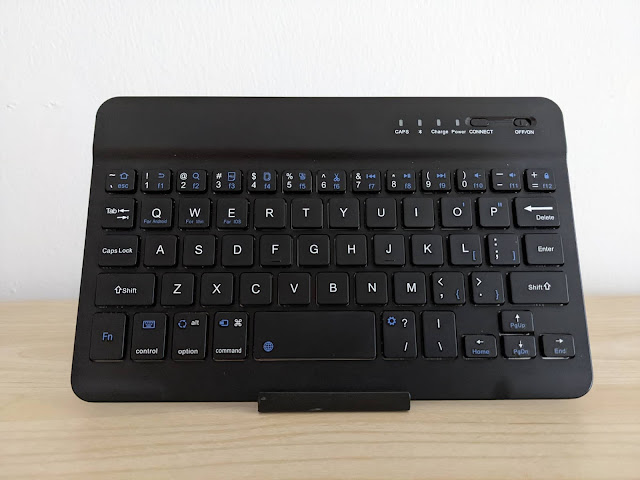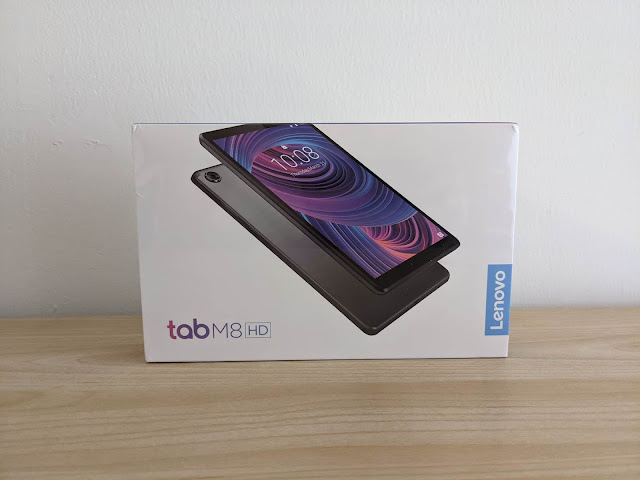Lenovo Tab E7 Tablet: First Impressions
I bought a Lenovo Tab E7 Android tablet.
It was sort of an impulse buy after seeing the device on display at a consumer electronics store and realizing how cheap it is. A buying decision made easier by some Amazon credit I had around. I got the 16 GB version for €74.99 at Amazon.
But there are other reasons I wanted a tablet.
When later getting the massive Nexus 6 phablet with its beautiful large screen, I began using the Nexus 7 less and less. When Google stopped providing system updates, I sold the remaining unit I still had.
Since then tablets have apparently gone out of favor with Android users. And manufacturers significantly cut down on the development and production of new models.
But I have always loved the slate form factor, particularly 7” tablets.
These tablets are small enough to be compact, but with a large enough screen to improve productivity with respect to smartphones. I liked the idea of a cheap tablet like entry level 7” Kindle Fire devices, but I didn’t want the Amazon ecosystem. I didn’t know true Android tablets could be so cheap until stumbling upon the E7 in the store.
Another motivation for getting the E7 is a tablet would let me learn more about Android outside of the stock Google experience, especially on operating and accessing microSD cards. This is useful to me, for example, for assisting a diverse Android user base in the Google help communities as part of my activities in the Google Product Experts Program.
For a smoother experience it’s better not to take two or more actions or gestures in rapid succession, such as tapping two user interface elements one immediately after the other. Instead, wait for the completion of an action or a screen redraw before taking the other.
Although the panel of the Lenovo Tab E7 has limited viewing angles, the ease of tilting it to an optimal angle makes this less of an issue.
I don’t install many apps on my Android devices, especially large apps. So the tablet’s 16 GB of local storage are enough for now. After installing the essential apps I need I have slightly over 10 GB left.
The tablet’s weight is not enough to be inconvenient when holding the device one-handed for the length of typical ebook reading sessions.
A full charge lasts 8-10 hours, close to the 8 hours listed in the device’s specs, with well over 6 hours of Screen on Time.
The device provides a near stock Google experience. It ships with a simple custom launcher similar to Google’s launchers, and half a dozen preinstalled apps besides the usual suite of Google apps. But using the device feels otherwise very similar to what I got on, say, Nexus devices.
Despite running Oreo now that Android 10 just came out, the system is up to date. As I write this the security patch listed in the settings is the latest monthly one.
The form factor, size, and weight put the device in a productivity sweet spot that more than offsets its limitations. Reading ebooks with apps such as Google Play Books or Kindle is an example of a noticeable productivity gain the tablet makes possible.
The E7’s 7” screen is the smallest that lets me read PDF files a complete page at a time at full screen. Text is large enough to read without strain and all the page fits on the screen.
The 7” screen is useful also for technical ebooks with source code in reflowable formats like ePub and Mobi. The panel’s width is enough to fit most 60-70 character source code lines in full without wrapping, which would make reading slower.
It was sort of an impulse buy after seeing the device on display at a consumer electronics store and realizing how cheap it is. A buying decision made easier by some Amazon credit I had around. I got the 16 GB version for €74.99 at Amazon.
But there are other reasons I wanted a tablet.
 |
| The home screen of my Lenovo Tab E7 tablet. |
Why I got a tablet
I owned and loved the Nexus 7 tablets, both the original 2012 and the 2013 version.When later getting the massive Nexus 6 phablet with its beautiful large screen, I began using the Nexus 7 less and less. When Google stopped providing system updates, I sold the remaining unit I still had.
Since then tablets have apparently gone out of favor with Android users. And manufacturers significantly cut down on the development and production of new models.
But I have always loved the slate form factor, particularly 7” tablets.
These tablets are small enough to be compact, but with a large enough screen to improve productivity with respect to smartphones. I liked the idea of a cheap tablet like entry level 7” Kindle Fire devices, but I didn’t want the Amazon ecosystem. I didn’t know true Android tablets could be so cheap until stumbling upon the E7 in the store.
Another motivation for getting the E7 is a tablet would let me learn more about Android outside of the stock Google experience, especially on operating and accessing microSD cards. This is useful to me, for example, for assisting a diverse Android user base in the Google help communities as part of my activities in the Google Product Experts Program.
The hardware
Although the tablet is unsurprisingly not snappy, and sometimes lags, performance is not so bad.For a smoother experience it’s better not to take two or more actions or gestures in rapid succession, such as tapping two user interface elements one immediately after the other. Instead, wait for the completion of an action or a screen redraw before taking the other.
Although the panel of the Lenovo Tab E7 has limited viewing angles, the ease of tilting it to an optimal angle makes this less of an issue.
 |
| Chrome running on my Lenovo Tab E7 tablet in landscape mode. |
I don’t install many apps on my Android devices, especially large apps. So the tablet’s 16 GB of local storage are enough for now. After installing the essential apps I need I have slightly over 10 GB left.
The tablet’s weight is not enough to be inconvenient when holding the device one-handed for the length of typical ebook reading sessions.
A full charge lasts 8-10 hours, close to the 8 hours listed in the device’s specs, with well over 6 hours of Screen on Time.
The software
The E7 runs Android Go with Android Oreo 8.1.0.The device provides a near stock Google experience. It ships with a simple custom launcher similar to Google’s launchers, and half a dozen preinstalled apps besides the usual suite of Google apps. But using the device feels otherwise very similar to what I got on, say, Nexus devices.
Despite running Oreo now that Android 10 just came out, the system is up to date. As I write this the security patch listed in the settings is the latest monthly one.
The usage experience
I’m impressed with the value this tablet brings for the price.The form factor, size, and weight put the device in a productivity sweet spot that more than offsets its limitations. Reading ebooks with apps such as Google Play Books or Kindle is an example of a noticeable productivity gain the tablet makes possible.
The E7’s 7” screen is the smallest that lets me read PDF files a complete page at a time at full screen. Text is large enough to read without strain and all the page fits on the screen.
The 7” screen is useful also for technical ebooks with source code in reflowable formats like ePub and Mobi. The panel’s width is enough to fit most 60-70 character source code lines in full without wrapping, which would make reading slower.


